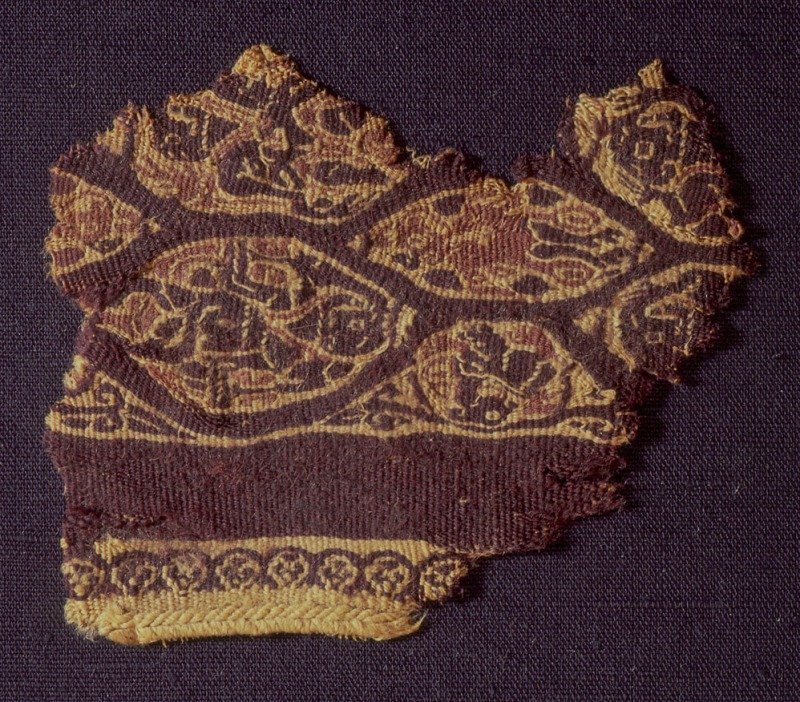
Tunic Fragment
Classical Antiquities
| Date | 330–360 A.D. |
|---|---|
| Object type | relief |
| Medium, technique | white limestone |
| Dimensions | 36.5 × 65 cm |
| Inventory number | 93.11.A |
| Collection | Classical Antiquities |
| On view | Museum of Fine Arts, Basement Floor, Classical Antiquity, Hellas – Italy – Rome |
This carved white limestone relief represents a hunting scene: the moment at the end of the chase when the hunter, a young centaur, throws himself with a final effort on his prey, a fleeing gazelle, which he wants to catch alive. The figure of the centaur and its prey emerge from a background of stylised acanthus scrolls, which build a complete medallion on the right side of the relief and about two-thirds of another medallion on its left side. The incomplete medallion indicates that the stone originally constituted part of a longer frieze. In the architectural carvings of late antique Egypt, figures highlighted by their sculptural features were central to the iconographic programme of buildings, forming the main foci at prominent points of the architecture. The late antique elite often articulated their views on their relationship with the gods, on their role in society, and on their rights and obligations vis-a-vis members of the family, by identifying themselves with mythological figures. A particularly important place for self-identification was the tomb, where the owner’s carved and painted representations carried the message of redemption, deification and eternal happiness earned through a virtuous life. As with the vast majority of late antique figurative and ornamental stone carvings found in Egypt, the Budapest relief of the hunting centaur was also made for a funerary edifice. In Egypt, as in other parts of the ancient world, the great popularity and diverse iconography of hunting led to it being interpreted as a symbol of virtuous life. Virtue was rewarded with eternal life: the victory of the hunter is the symbol of triumph over death. This view of hunting was most effectively formulated in the myth of Dionysos, in which the god appears as Dionysos Zagreus, catching wild beasts alive. The inclusion of centaurs into the myth of Dionysos was originally inspired by the god’s role related to the underworld in the religion of Southern Italian Greeks: there are terracottas from Tarentum which depict centaurs carrying the dead on their backs, while Virgil and others held centaurs to be guardians of the gate of the underworld. The association of the centaurs with concerns about the afterlife received its clearest expression in the decoration of 2nd- and 3rd-century A.D. Roman sarcophagus reliefs showing the triumphal procession of Dionysos. The central theme of these scenes, similarly to the decorative scheme of the relief which the Budapest piece formed a part of, is the god’s victory as a metaphor for redemption. The hunting centaur of the relief alludes both to the triumph of Good over Evil and to the centaur guiding the souls in Roman funerary art, while the gazelle he captures was a sacrificial animal in Egyptian tradition. The Egyptian religion of the Graeco-Roman period identified Dionysos with Osiris, whereas the figure of the gazelle was associated with Seth, the murderer of Osiris. In Greek mythology, maenads and satyrs sacrificed a goat to Dionysos. The hypothesis that the prey of the Budapest Centaur is a sacrifice to be brought before Dionysos is also supported by its being captured alive, just as Dionysos catches his sacrificial goat alive. The naturalism of Egyptian art in late antiquity merges with stylistic features of symbolic abstraction that started to develop in the late 3rd century. The centaur and his prey were carved by an artist of first-rate abilities, while the acanthus scrolls are the work of a less talented artisan who specialised in ornamentation. The anatomically correct but simplified depiction of the bodies, and the painstaking modelling of the heads of the centaur and the gazelle attest a familiarity with the classicist school dominating centres of sculpture in the early 4th century. However, the stylistic features clearly show that the artists who carved the Budapest relief worked in the distinctive local style of Oxyrhynchos which differed in many respects from the general development of late antique sculpture in Egypt, combining the archaic with the traditional, the “modern” Egyptian with the Roman. Following LÁSZLÓ TÖRÖK
This record is subject to revision due to ongoing research.